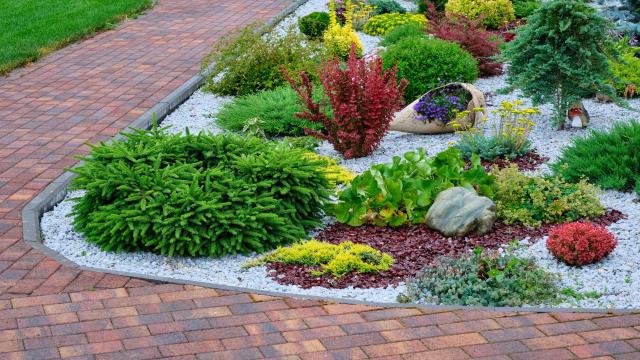If you’re tired of watering your lawn to keep it alive, or if you live somewhere with water use restrictions, you may have given up on having a garden. In places where it’s hard to keep traditional landscaping plants alive, or for people who want a low-maintenance, cost-effective alternative to a lawn, a gravel garden is a great choice. Using gravel as a border, a growing medium, or even for colour is easy to do yourself with a few tools and materials.
For this project, you’ll need a shovel, a soil tamper, weed barrier, landscaping grid, gravel, a rake, and depending on the size of the space you’re working in, a wheelbarrow and gravel-spreader. You will also need some gravel-loving plants if you plan to use the gravel itself as a growing medium.
How to install a low-maintenance gravel garden
The installation method is what makes a gravel garden low maintenance. The first step is to remove the grass and weeds and then tamp down the soil to get an even surface. It’s OK to have a gentle slope, but if the ground is pitched too steeply, it will be hard to keep the gravel in place. Once you have the area clear, lay down a weed barrier to keep the area free of weeds once the gravel is in place. Use a landscaping grid and a border to keep the gravel from washing away and to help separate the gravel area from the surrounding ground will make look more finished.
Once you have your area prepared, you can choose from many different types of gravel depending on your taste. Pea gravel tends to be the cheapest, but you can also find river rock and marble chip gravel for relatively cheap. Use the landscaping grid or border material to make a pattern and add some interest to your gravel landscaping. There are lots of gravel types to choose from, so you can find a colour and shape that works for you.
How to choose the right plants for a gravel garden
Next, add some plants that you like. You can either arrange garden beds to go directly into the gravel, or leave yourself some bed space with traditional soil. Succulents like sedum and stonecrop are well-adapted to thrive in a gravel bed, as are rock-rooting plants like sedge grass and ajuga. Other drought-resistant plants for a gravel garden include thistle, sage, and ice plant. You can choose a variety of flowering plants to add some colour from spring through fall. If you choose to leave some soil for your beds, plants that are adapted to your geographic location will work best. You can also add container plants into your design to add levels to your landscape.
Since most gravel-dwelling plants don’t need a lot of care, you can basically set it and forget it once your plants are in. You will likely need to trim back any cascading or creeping plants once per season to keep them from growing over pathways; aside from that, an occasional weeding will do, and use a rake to flatten down the gravel once a season.

Leave a Reply
You must be logged in to post a comment.